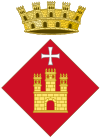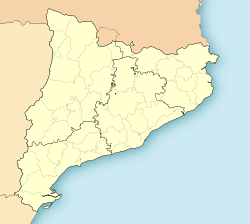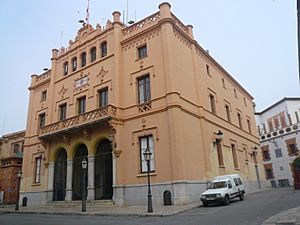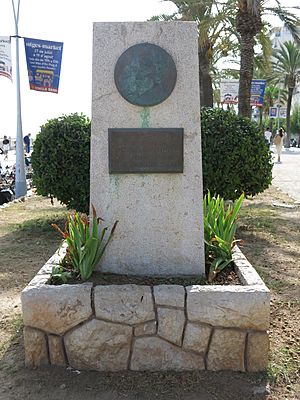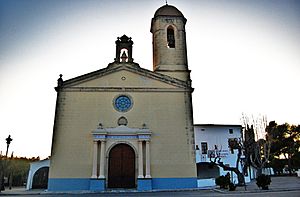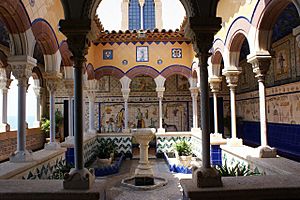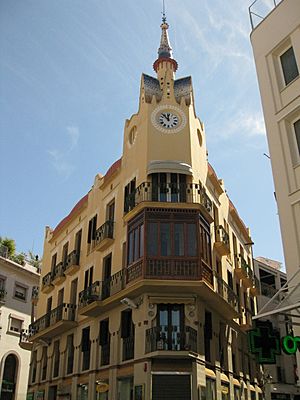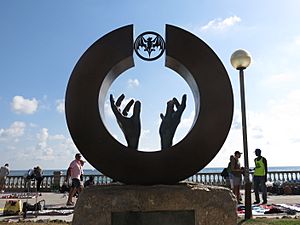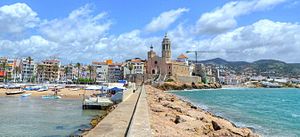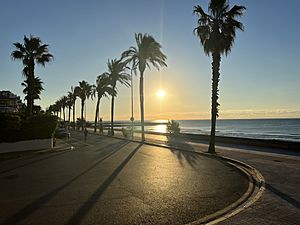Sitges facts for kids
Quick facts for kids
Sitges
|
|||
|---|---|---|---|
|
Municipality
|
|||
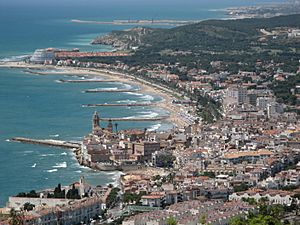
Sitges
|
|||
|
|||
| Nickname(s):
Blanca Subur
|
|||
| Country | Spain | ||
| Autonomous community | Catalonia | ||
| Province | Barcelona | ||
| Comarca | Garraf | ||
| Judicial district | Vilanova i la Geltrú | ||
| Area | |||
| • Total | 43.85 km2 (16.93 sq mi) | ||
| Elevation | 10 m (30 ft) | ||
| Highest elevation | 591 m (1,939 ft) | ||
| Population
(2023)
|
|||
| • Total | 32,086 | ||
| • Density | 731.72/km2 (1,895.15/sq mi) | ||
| Demonym(s) | sitgetà (m), sitgetana (f) | ||
| Time zone | UTC+1 (CET) | ||
| • Summer (DST) | UTC+2 (CEST) | ||
| Postal code |
08870
|
||
| Dialing code | 93 | ||
| Official languages | Catalan Spanish |
||
Sitges is a beautiful town located about 35 kilometers southwest of Barcelona in Catalonia, Spain. It is famous around the world for its exciting Sitges Film Festival, lively Carnival, and welcoming atmosphere for all visitors. Sitges sits between the Garraf Massif mountains and the Mediterranean Sea. It is well-known for its lovely beaches, fun nightspots, and interesting historical places.
Sitges became known for its art in the late 1800s. This was when the famous painter Santiago Rusiñol started spending his summers there. Later, in the 1960s, it became a popular spot for new ideas and culture in Spain. People even called it "Ibiza in miniature."
Today, Sitges relies on tourism and culture for its economy. It has over 4,500 hotel rooms, with many being four-star hotels. Sitges is a very welcoming place for everyone, including the LGBT community. It has many places that cater to all visitors and popular beaches.
About 35% of the 26,000 people who live in Sitges permanently are from other countries. Many come from the Netherlands, the UK, France, and Scandinavia. Their children often go to international schools in the area. The town also has 17 beautiful beaches.
Sitges is sometimes called the Saint-Tropez of Spain. Property prices here are quite high, similar to some of the most expensive cities in Europe. This is mainly because of its stunning seaside location and the nearby Garraf Park. Being close to Barcelona-El Prat Airport is also a big plus.
Contents
History of Sitges
The name of the town, Sitges, comes from a Catalan word meaning "silos." Silos are places used to store grain.
Ancient Times
People have lived in the Sitges area since at least the Neolithic era, which was a very long time ago. An Iberian settlement was here in the 4th century BC. Later, in the 1st century BC, there were two separate villages. These villages were eventually taken over by the Romans.
Middle Ages and Beyond
During the Middle Ages, a castle was built in Sitges. It was first owned by the bishop of Barcelona. Later, it was given to Count Mir Geribert in 1041. In the 12th century, the town came under the control of the Sitges family. They owned it until 1308. Then, Agnes of Sitges sold the town to Bernat de Fonollar. After he passed away, it went to a charity called Pia Almoina. This charity owned Sitges until 1814.
The "Americanos"
From the late 1700s to the early 1900s, Sitges had strong ties to Spain's lands overseas, especially Cuba. Many young people from Sitges moved to places like Santiago de Cuba and Guantánamo. Most of them worked in business, often for relatives already living there. Some became very successful and started big companies. Examples include Facundo Bacardí, who founded Ron Bacardí, and Jaime Brugal, who later started Ron Brugal in the Dominican Republic.
Some of these people, after making a lot of money, moved back to Sitges. They were known as "Americanos." These "Americanos" left a lasting mark on Sitges. You can still see their influence in the town's buildings and the history of many local families.
Modern Sitges
After Spain lost its overseas lands in 1898, people from Sitges still moved to Cuba, but trade slowed down. Sitges then found its main market within Spain. Shoe making became very important to Sitges' economy in the early 1900s. The first machine-powered shoe factory in Spain opened in Sitges in 1874. This led to a strong shoe-making industry. By the mid-1900s, about 80% of local workers were in this industry.
However, the rise of tourism in the 1960s changed everything. Tourism became the main part of Sitges' economy.
Sitges as an Artistic Hub
Because artists like Santiago Rusiñol moved to Sitges, wealthy families from Barcelona also built summer homes there. The area known as Terramar became a beautiful garden city. Sitges gained an international reputation and attracted famous people.
An American businessman and art collector named Charles Deering had a large art collection in Sitges from 1910 to 1921. He built the amazing Palau Maricel (Maricel Palace). Famous thinkers like G. K. Chesterton visited the town in 1926 and 1935. Even the German boxer Max Schmelling trained in Sitges in 1934.
During the Civil War (1936-1939), Sitges was mostly controlled by one side. After the war, the town was taken by the other side in January 1939. The British war journalist Henry Buckley, who wrote about the Spanish Republic, lived in Sitges for a few months during the war. He later retired there in the 1960s.
In 1958, political leaders from Colombia met in Sitges. They signed a peace agreement called the "Declaration of Sitges." This agreement helped create a shared government in Colombia.
Geography of Sitges
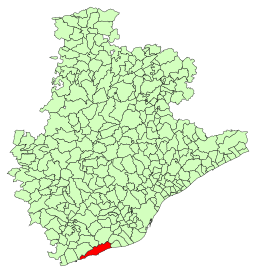
The town of Sitges is part of the Garraf area in Catalonia. It is surrounded by other towns. To the north are Olivella and Begues. To the west are Sant Pere de Ribes and Vilanova i la Geltrú. To the east are Gavà and Castelldefels. To the south is the beautiful Mediterranean Sea.
Sitges Carnival
For over a hundred years, Sitges has celebrated Carnestoltes, also known as Carnival. This big party happens between February and March each year. The fun starts on Fat Thursday with the arrival of King Carnestoltes. It continues until Ash Wednesday, when they have a special "burial of the sardine" event.
Traditional Folk dances and xatonades (a local salad with omelets) are also a big part of Carnival. The two most exciting events are the Debauchery Parade on Sunday night and the Extermination Parade on Tuesday night. About forty floats with more than 2,000 people fill the streets of Sitges. Many people come from all over to see this amazing celebration.
Food and Drink
Xató is the most famous dish from Sitges. It is a special salad. The first time it was mentioned in writing was in a local newspaper in 1896. It talked about a meal that included famous artists like Santiago Rusiñol.
Malvasia is a sweet, delicate wine often served in Sitges, especially with dessert. This wine gets its name from a port called Monemvasía.
Museums to Visit
Sitges has several interesting museums:
- Cau Ferrat Museum
- Museu Romàntic Can Llopis
- Maricel Museum
- Fundació Stämpfli Contemporary Art
Beaches of Sitges
Sitges is home to 17 sandy beaches. Four of these are on the east side of town. The first one is called Les Botigues. The other three follow the coast of Garraf. One of these is the beach at Garraf village.
There are eleven beaches right in the town itself. Two more beaches are to the west, but they are a bit harder to reach.
All the beaches on the east side and in the town have flags that show the condition of the sea. Most of them have special quality awards and blue flags from the European Union. This means they are clean and safe.
Education in Sitges
Sitges has several public primary schools where children learn in Catalan. These include Escola Agnès de Sitges, Escola Esteve Barrachina, Escola Maria Ossó, Escola Miquel Utrillo, and Escola Pia Sitges. There is also a Catholic school called Camp Joliu.
For private education, there is the French Lycée Bel Air, and the English Richmond International and The Olive Tree School.
The British School of Barcelona (BSB) also has a campus in Sitges. It provides education for primary school children (ages 3-11) and is located in the nice neighborhood of Vallpineda.
The Institute of the Arts Barcelona is a top international college for performing arts training. It is based in the Terramar area of Sitges.
Sister Cities
Sitges has one sister city:
Motor Racing History
Sitges has a long and interesting connection to motor racing in Catalonia. From 1908 to 1920, races were held on public roads around Sitges.
In 1922 and 1923, the Real Moto Club de Catalunya held the Penya Rhin Grand Prix. This race took place on a 9-mile track near the town of Vilafranca del Penedès. Later, a special race track was built called the Autódromo de Sitges-Terramar. This track has famously steep banks and you can still see it today at 41°14′18.35″N 1°46′50.20″E / 41.2384306°N 1.7806111°E. Albert Divo won the only Spanish Grand Prix held at this track, driving a Sunbeam.
Famous People from Sitges
- Rafael Font Farran (1912–2003), a politician and journalist
- Facundo Bacardí (1814–1886), a successful businessman
- Mir Geribert (died 1060), a Catalan nobleman
- Santiago Rusiñol (1861–1931), a famous artist
- Arcadi Mas i Fondevila (1852–1934), an artist
- Christopher Small (1927–2011), a musician and expert in music from different cultures
- Miguel Condé (1939), a painter
Images for kids
See also
 In Spanish: Sitges para niños
In Spanish: Sitges para niños



